CHEVROLET EXPRESS PASSANGER 2007 1.G Owners Manual
Manufacturer: CHEVROLET, Model Year: 2007, Model line: EXPRESS PASSANGER, Model: CHEVROLET EXPRESS PASSANGER 2007 1.GPages: 458, PDF Size: 2.62 MB
Page 111 of 458
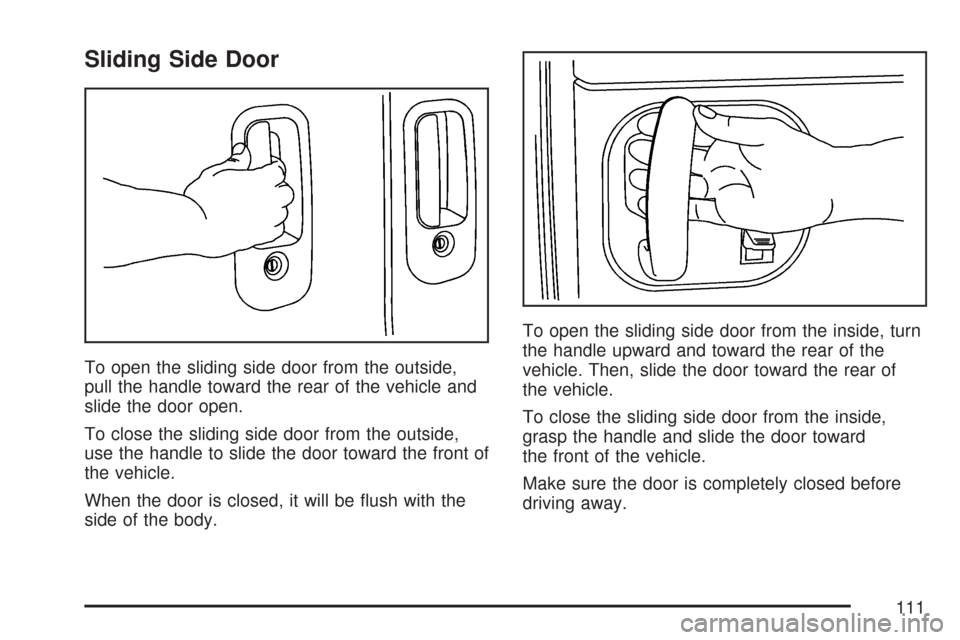
Sliding Side Door
To open the sliding side door from the outside,
pull the handle toward the rear of the vehicle and
slide the door open.
To close the sliding side door from the outside,
use the handle to slide the door toward the front of
the vehicle.
When the door is closed, it will be flush with the
side of the body.To open the sliding side door from the inside, turn
the handle upward and toward the rear of the
vehicle. Then, slide the door toward the rear of
the vehicle.
To close the sliding side door from the inside,
grasp the handle and slide the door toward
the front of the vehicle.
Make sure the door is completely closed before
driving away.
111
Page 112 of 458
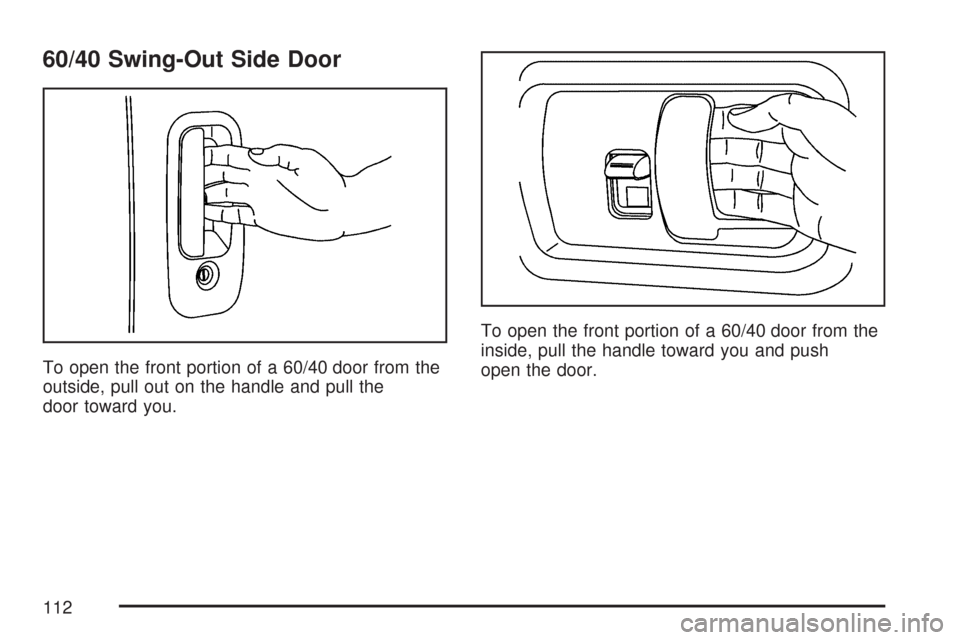
60/40 Swing-Out Side Door
To open the front portion of a 60/40 door from the
outside, pull out on the handle and pull the
door toward you.To open the front portion of a 60/40 door from the
inside, pull the handle toward you and push
open the door.
112
Page 113 of 458
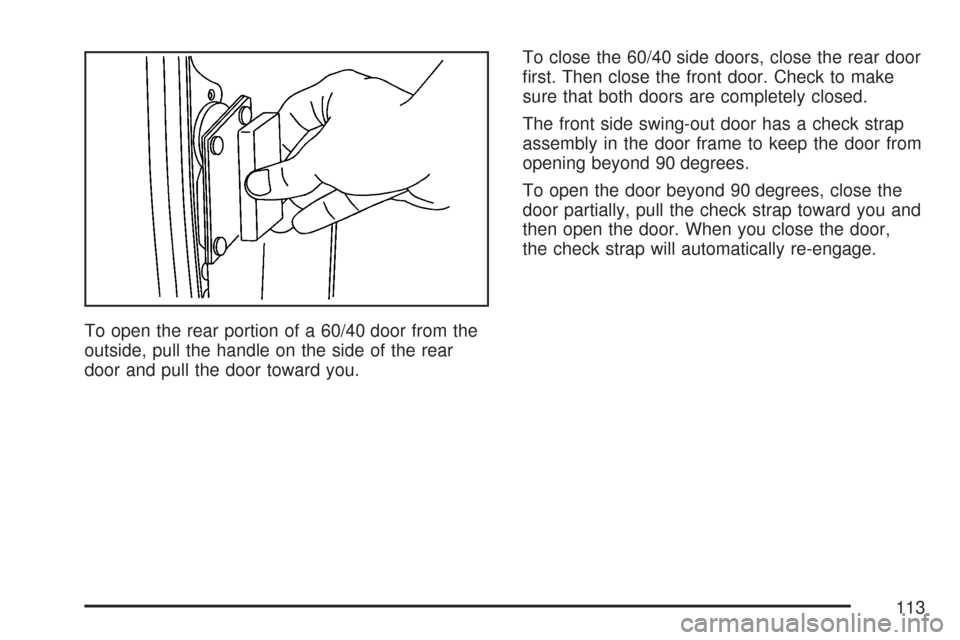
To open the rear portion of a 60/40 door from the
outside, pull the handle on the side of the rear
door and pull the door toward you.To close the 60/40 side doors, close the rear door
first. Then close the front door. Check to make
sure that both doors are completely closed.
The front side swing-out door has a check strap
assembly in the door frame to keep the door from
opening beyond 90 degrees.
To open the door beyond 90 degrees, close the
door partially, pull the check strap toward you and
then open the door. When you close the door,
the check strap will automatically re-engage.
113
Page 114 of 458
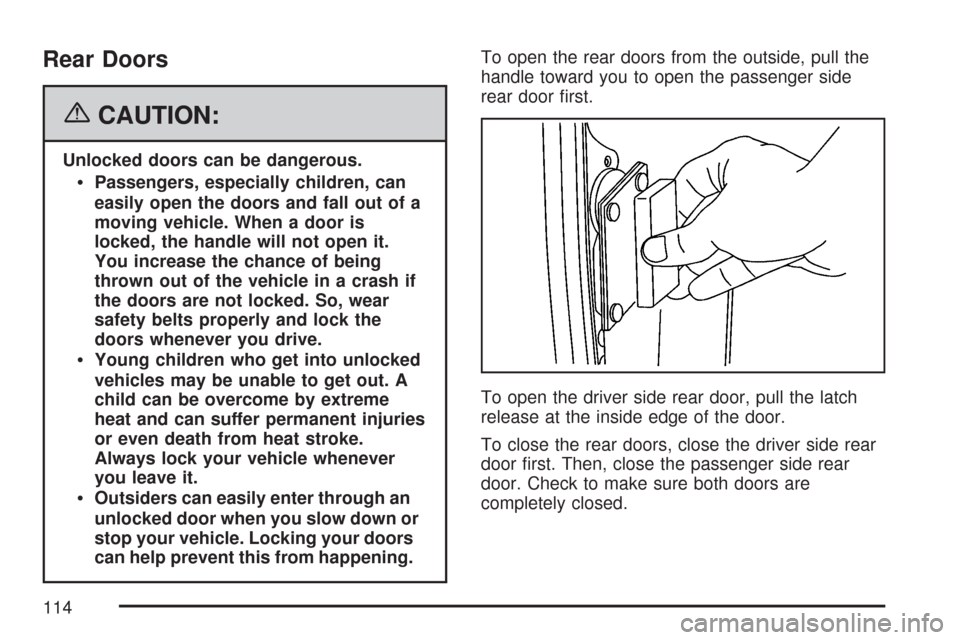
Rear Doors
{CAUTION:
Unlocked doors can be dangerous.
Passengers, especially children, can
easily open the doors and fall out of a
moving vehicle. When a door is
locked, the handle will not open it.
You increase the chance of being
thrown out of the vehicle in a crash if
the doors are not locked. So, wear
safety belts properly and lock the
doors whenever you drive.
Young children who get into unlocked
vehicles may be unable to get out. A
child can be overcome by extreme
heat and can suffer permanent injuries
or even death from heat stroke.
Always lock your vehicle whenever
you leave it.
Outsiders can easily enter through an
unlocked door when you slow down or
stop your vehicle. Locking your doors
can help prevent this from happening.To open the rear doors from the outside, pull the
handle toward you to open the passenger side
rear door first.
To open the driver side rear door, pull the latch
release at the inside edge of the door.
To close the rear doors, close the driver side rear
door first. Then, close the passenger side rear
door. Check to make sure both doors are
completely closed.
114
Page 115 of 458
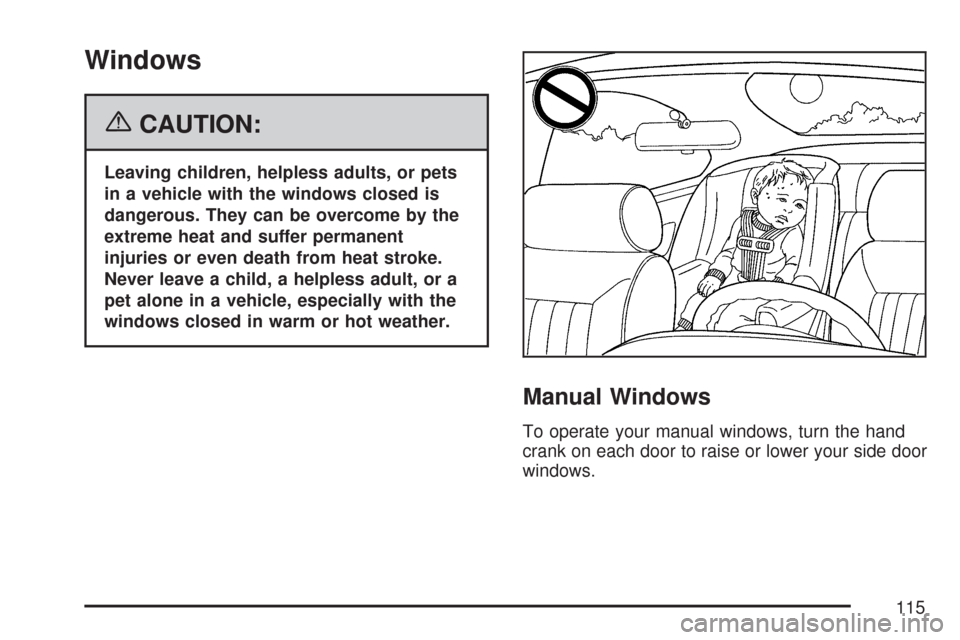
Windows
{CAUTION:
Leaving children, helpless adults, or pets
in a vehicle with the windows closed is
dangerous. They can be overcome by the
extreme heat and suffer permanent
injuries or even death from heat stroke.
Never leave a child, a helpless adult, or a
pet alone in a vehicle, especially with the
windows closed in warm or hot weather.
Manual Windows
To operate your manual windows, turn the hand
crank on each door to raise or lower your side door
windows.
115
Page 116 of 458
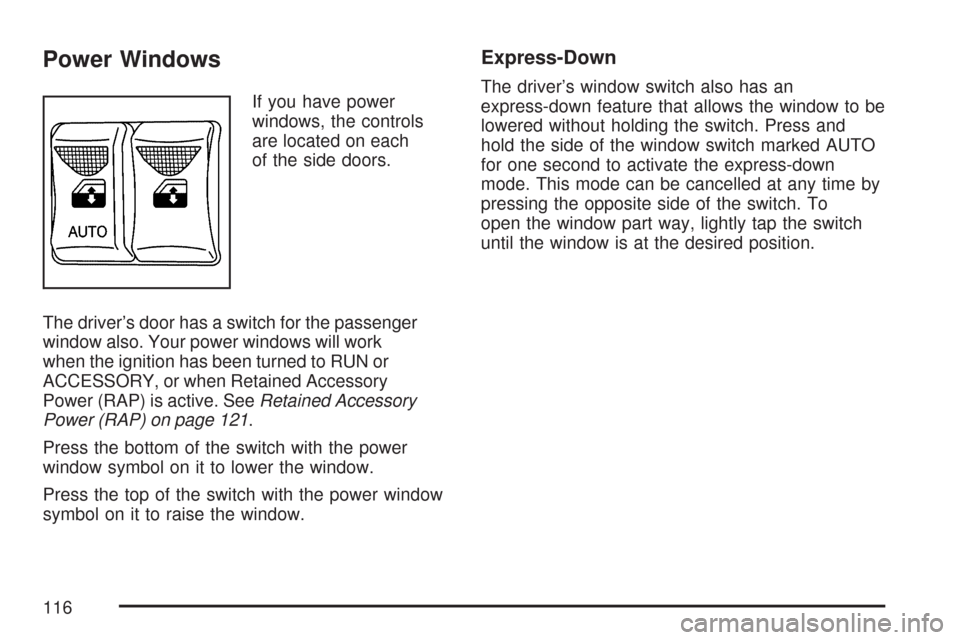
Power Windows
If you have power
windows, the controls
are located on each
of the side doors.
The driver’s door has a switch for the passenger
window also. Your power windows will work
when the ignition has been turned to RUN or
ACCESSORY, or when Retained Accessory
Power (RAP) is active. SeeRetained Accessory
Power (RAP) on page 121.
Press the bottom of the switch with the power
window symbol on it to lower the window.
Press the top of the switch with the power window
symbol on it to raise the window.
Express-Down
The driver’s window switch also has an
express-down feature that allows the window to be
lowered without holding the switch. Press and
hold the side of the window switch marked AUTO
for one second to activate the express-down
mode. This mode can be cancelled at any time by
pressing the opposite side of the switch. To
open the window part way, lightly tap the switch
until the window is at the desired position.
116
Page 117 of 458
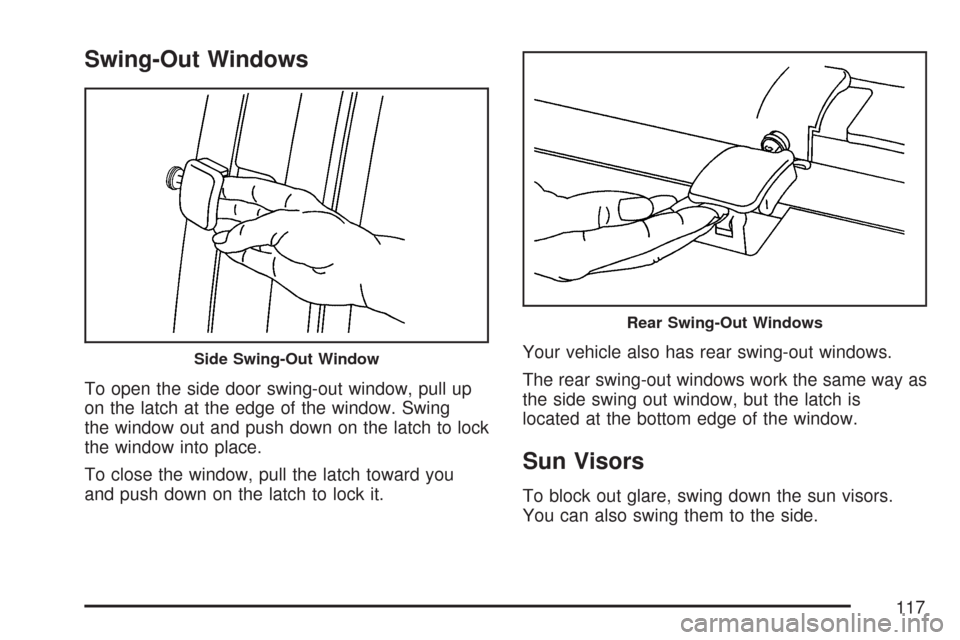
Swing-Out Windows
To open the side door swing-out window, pull up
on the latch at the edge of the window. Swing
the window out and push down on the latch to lock
the window into place.
To close the window, pull the latch toward you
and push down on the latch to lock it.Your vehicle also has rear swing-out windows.
The rear swing-out windows work the same way as
the side swing out window, but the latch is
located at the bottom edge of the window.
Sun Visors
To block out glare, swing down the sun visors.
You can also swing them to the side.
Side Swing-Out Window
Rear Swing-Out Windows
117
Page 118 of 458
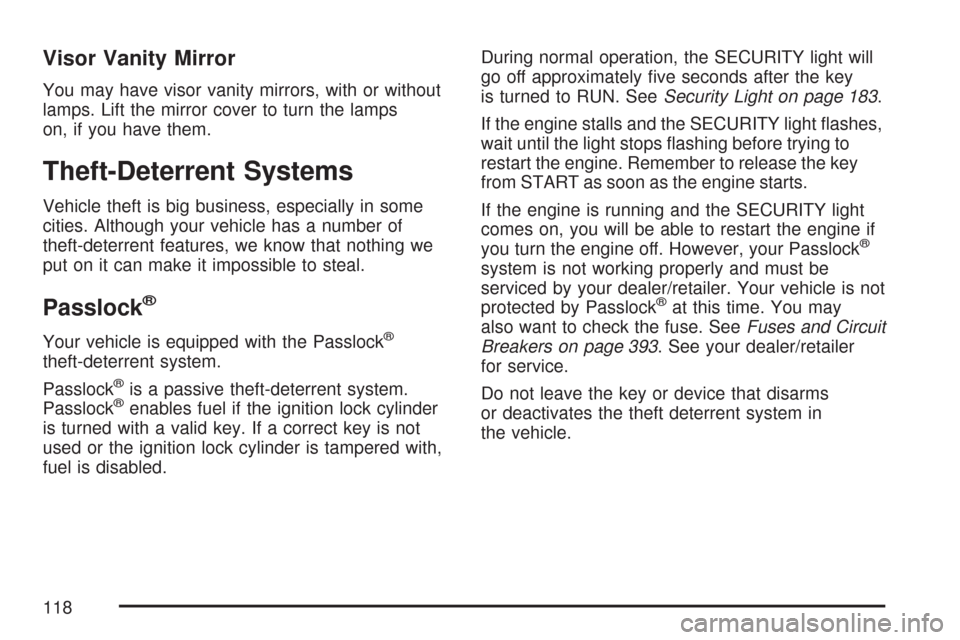
Visor Vanity Mirror
You may have visor vanity mirrors, with or without
lamps. Lift the mirror cover to turn the lamps
on, if you have them.
Theft-Deterrent Systems
Vehicle theft is big business, especially in some
cities. Although your vehicle has a number of
theft-deterrent features, we know that nothing we
put on it can make it impossible to steal.
Passlock®
Your vehicle is equipped with the Passlock®
theft-deterrent system.
Passlock
®is a passive theft-deterrent system.
Passlock®enables fuel if the ignition lock cylinder
is turned with a valid key. If a correct key is not
used or the ignition lock cylinder is tampered with,
fuel is disabled.During normal operation, the SECURITY light will
go off approximately five seconds after the key
is turned to RUN. SeeSecurity Light on page 183.
If the engine stalls and the SECURITY light flashes,
wait until the light stops flashing before trying to
restart the engine. Remember to release the key
from START as soon as the engine starts.
If the engine is running and the SECURITY light
comes on, you will be able to restart the engine if
you turn the engine off. However, your Passlock
®
system is not working properly and must be
serviced by your dealer/retailer. Your vehicle is not
protected by Passlock
®at this time. You may
also want to check the fuse. SeeFuses and Circuit
Breakers on page 393. See your dealer/retailer
for service.
Do not leave the key or device that disarms
or deactivates the theft deterrent system in
the vehicle.
118
Page 119 of 458
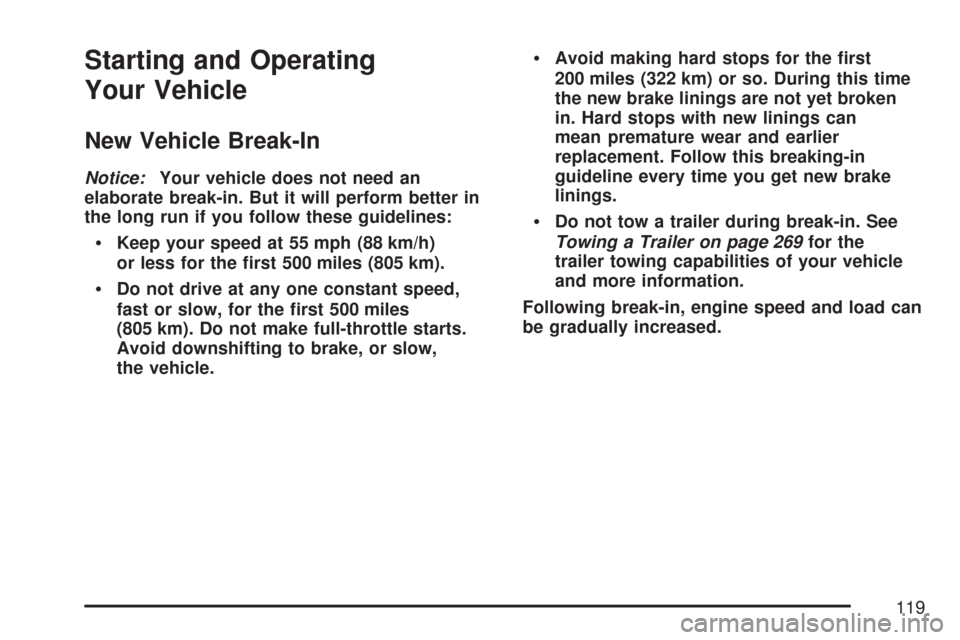
Starting and Operating
Your Vehicle
New Vehicle Break-In
Notice:Your vehicle does not need an
elaborate break-in. But it will perform better in
the long run if you follow these guidelines:
Keep your speed at 55 mph (88 km/h)
or less for the �rst 500 miles (805 km).
Do not drive at any one constant speed,
fast or slow, for the �rst 500 miles
(805 km). Do not make full-throttle starts.
Avoid downshifting to brake, or slow,
the vehicle.
Avoid making hard stops for the �rst
200 miles (322 km) or so. During this time
the new brake linings are not yet broken
in. Hard stops with new linings can
mean premature wear and earlier
replacement. Follow this breaking-in
guideline every time you get new brake
linings.
Do not tow a trailer during break-in. See
Towing a Trailer on page 269for the
trailer towing capabilities of your vehicle
and more information.
Following break-in, engine speed and load can
be gradually increased.
119
Page 120 of 458
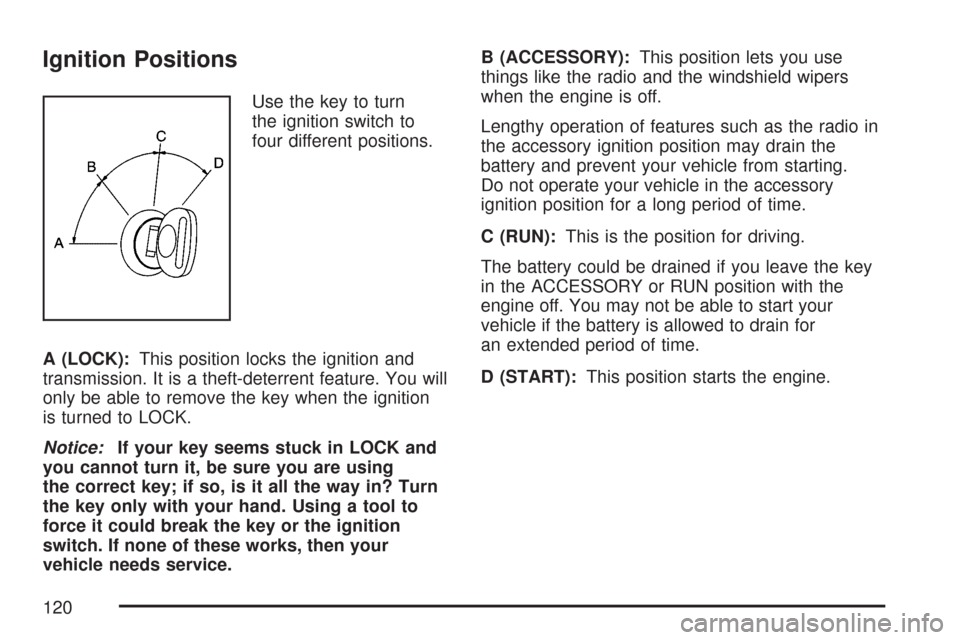
Ignition Positions
Use the key to turn
the ignition switch to
four different positions.
A (LOCK):This position locks the ignition and
transmission. It is a theft-deterrent feature. You will
only be able to remove the key when the ignition
is turned to LOCK.
Notice:If your key seems stuck in LOCK and
you cannot turn it, be sure you are using
the correct key; if so, is it all the way in? Turn
the key only with your hand. Using a tool to
force it could break the key or the ignition
switch. If none of these works, then your
vehicle needs service.B (ACCESSORY):This position lets you use
things like the radio and the windshield wipers
when the engine is off.
Lengthy operation of features such as the radio in
the accessory ignition position may drain the
battery and prevent your vehicle from starting.
Do not operate your vehicle in the accessory
ignition position for a long period of time.
C (RUN):This is the position for driving.
The battery could be drained if you leave the key
in the ACCESSORY or RUN position with the
engine off. You may not be able to start your
vehicle if the battery is allowed to drain for
an extended period of time.
D (START):This position starts the engine.
120